Reading Time: 9 minutes
Ever stood by a freshwater stream at dawn, watching the calm surface? While it may seem peaceful up top, there’s a bustling world underneath. And usually, there’s a Trout on the move, hunting down its next snack.
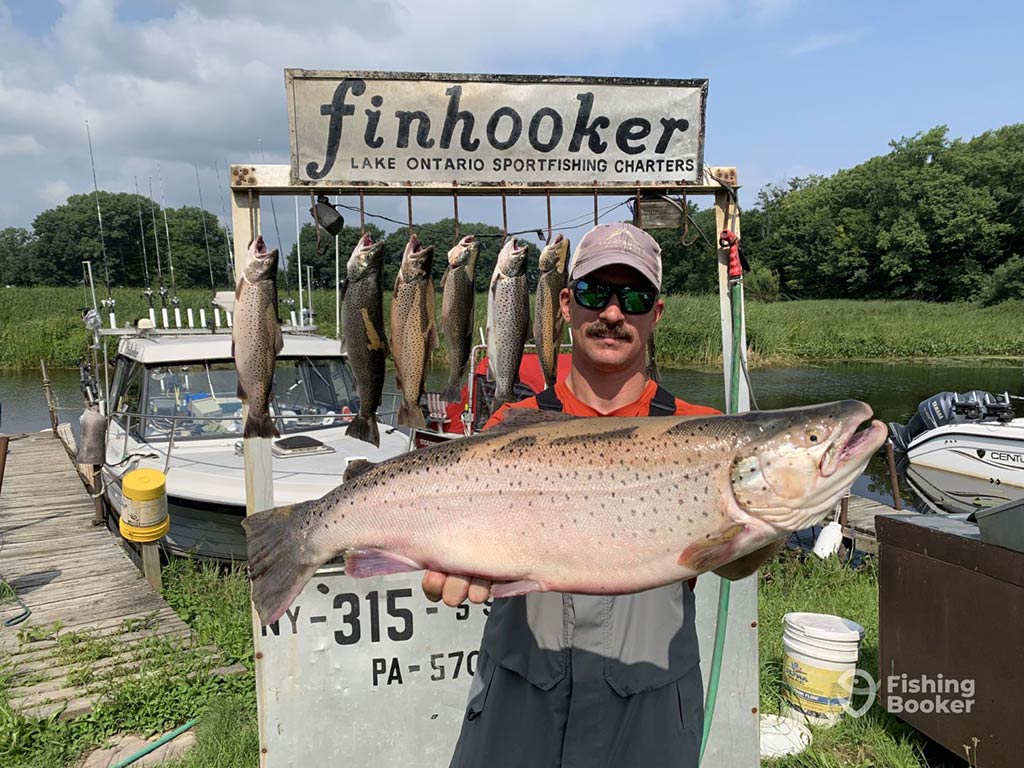
Photo courtesy of Finhooker Charters
You may think that sounds like catching Trout is easy. But Trout fishing isn’t just about throwing a line in! It’s a science and an art. It’s about deciphering the water’s hints, predicting the fish’s movements, and waiting for that thrilling moment when a fish bites.
Every angler has their go-to spot or a favorite tale, but one thing binds them all – the power of the right bait. Your bait choice can mean the difference between boasting a great catch or reminiscing about the one that slipped away.
This guide is your deep dive into the best bait for Trout. I’ll decode Trout habits and sift through bait options. Gear up, because we’re about to uncover your fishing potential…
Trout Bait Basics
All kinds of freshwater Trout are revered by anglers for their beauty, fight, and the pristine environments they inhabit. These elusive fish require a keen understanding and the right choice of bait to increase the chance of a successful catch.
In this section, I’ll dive into the foundational knowledge needed to select the perfect bait for Trout fishing, setting you on the path to a fruitful angling adventure.
Understanding Trout Behavior
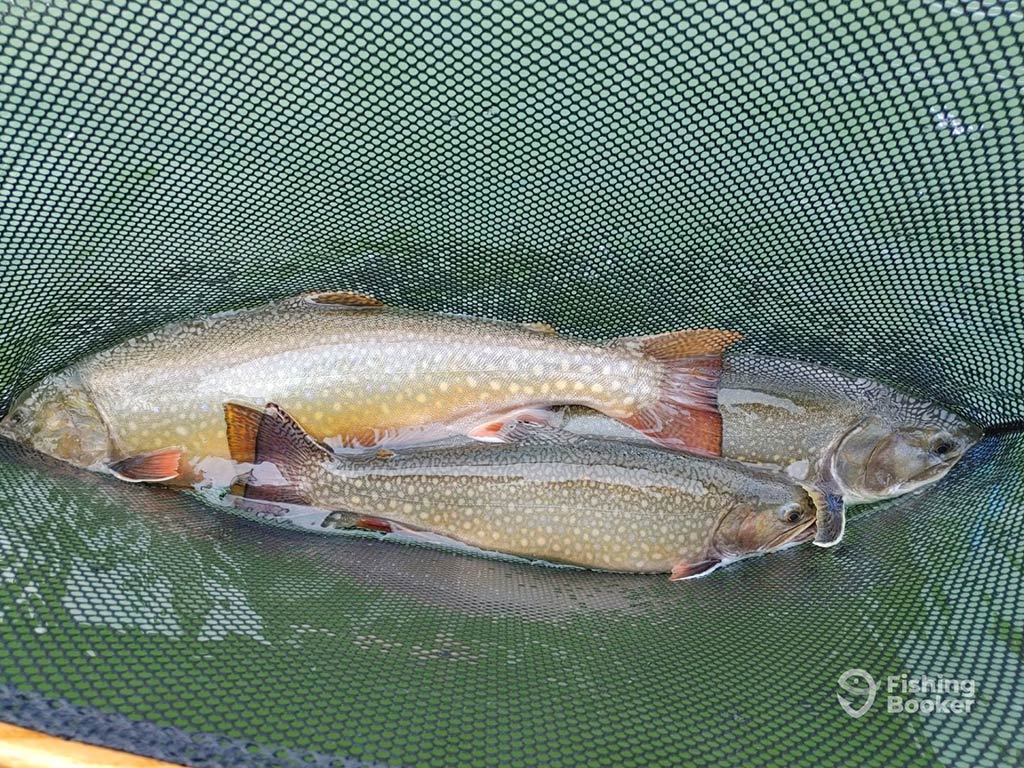
Photo courtesy of Hot Take Angling
To truly master the art of Trout fishing, you must first understand the behavior and feeding habits of these elusive species. Trout are visual hunters, primarily relying on their keen eyesight to spot prey.
Their diet can range from small bait fish and aquatic insects to crustaceans and even other smaller fish species. In clearer waters, they’re known for their cautious and sometimes finicky nature, which can pose a challenge for even the most seasoned angler.
Local Forage and Its Importance
Matching the local forage is a principle as old as fishing itself. Before selecting a bait, take a moment to understand what the Trout in your chosen location are feeding on.
In freshwater streams, insects such as mayflies, caddisflies, and stoneflies often form a significant portion of a Trout’s diet. In larger bodies of water like lakes and reservoirs, bait fish such as minnows or small chubs can be the go-to meal.
Sensory Appeal: Sight, Scent, and Vibration
Brown Trout and Rainbow Trout, in particular, have an acute sense of smell. While they largely rely on their sight for hunting, in murkier waters or during low light conditions, scent can play a crucial role. Similarly, vibrations or movement in the water can attract Trout, especially when they’re in a more aggressive feeding mode.
Color Considerations
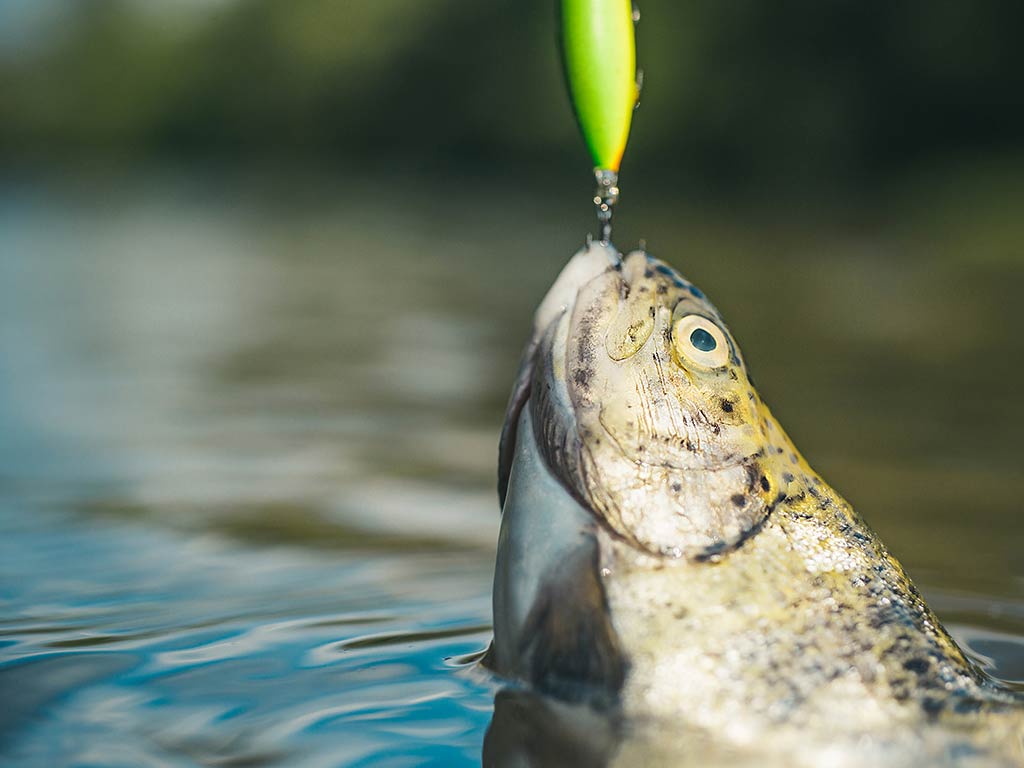
Water depth and clarity can greatly affect how a Trout perceives the color of your bait. In deeper waters, certain colors may appear muted or entirely different. For example, red, which may look vibrant close to the surface, can appear gray or even black in deeper sections.
Research has shown that Trout often respond well to baits in brighter shades like chartreuse, orange, or even white, especially in clearer waters. In murkier waters, contrast becomes more essential, and darker colors can stand out better.
Seasonal Variations in Diet
Just like any species, Trout feeding habits change with the season. In cooler months, they become more lethargic and prefer easy, energy-conserving meals.
This means they might be more attracted to slower-moving or stationary bait. As temperatures rise in spring and summer, Trout become more active, moving into shallower waters and chasing after larger, more mobile prey. During this time, they might show a preference for live bait or lures that mimic the swift movement of small fish.
Understanding these Trout bait basics will not only increase your chances of landing a catch but will also deepen your connection with your surrounding natural environment, making each fishing trip a memorable experience. With these principles in mind, let’s delve into the specific bait choices that can enhance your Trout fishing adventure.
What’s the best bait to use for Trout?
Fishing, at its core, is about understanding and mimicking the natural environment. Trout, being opportunistic feeders, can be picky, and your bait should reflect what they’re naturally inclined to eat at any given time.
Observing the ecosystem can provide vital cues. Depending on the season and location, Trout diets can shift from aquatic insects to smaller fish, and even terrestrial bugs that get trapped in the water. Your bait choice should echo this diversity.
Live Bait
Earthworms
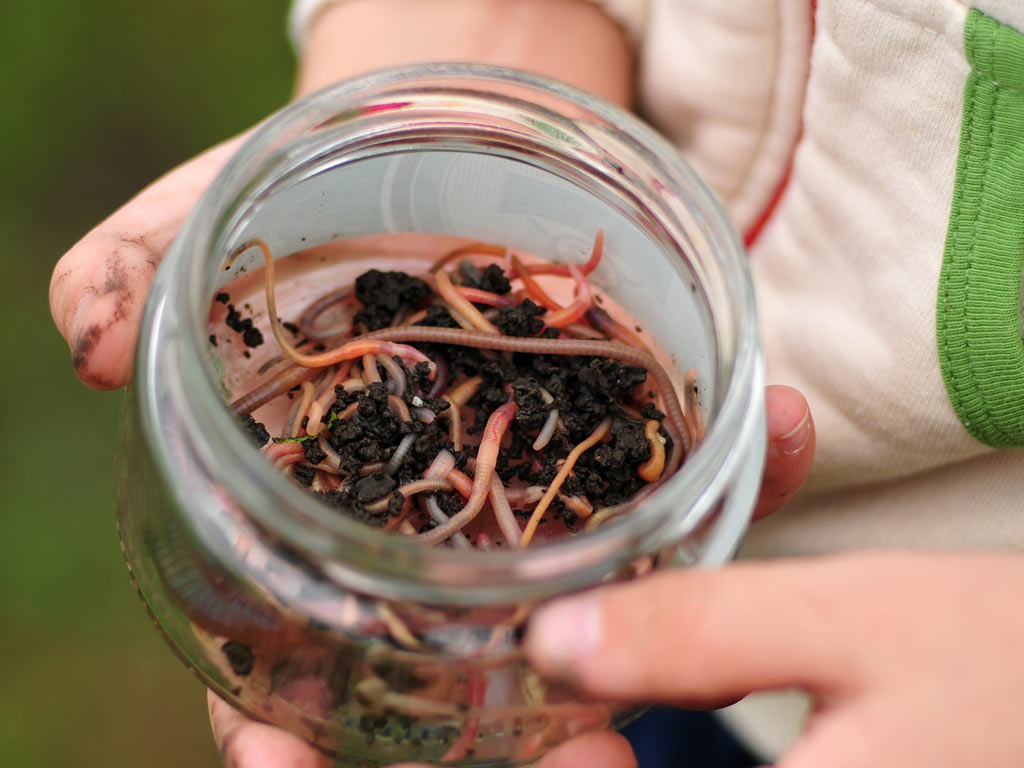
A long-standing favorite among anglers, earthworms are often considered a fail-safe bait for Trout. They imitate many aquatic insect larvae, which are staples in a Trout’s diet.
In deeper water bodies, larger nightcrawlers can be especially enticing, drawing out the bigger Trout from their hiding spots. Meanwhile, in shallow streams, the more diminutive red worms often prove irresistible, reflecting the smaller organisms that Trout typically encounter in such environments.
Crickets and Grasshoppers
Crickets and grasshoppers are also terrestrial creatures, but they’re frequently found atop water surfaces, particularly during warmer months. To Trout, these are accidental, yet delightful snacks.
While crickets tend to float and flutter, mimicking an insect in distress, grasshoppers possess a more pronounced ability to kick and splash, attracting attention. Both these insects, with their erratic surface movements, can entice a strike from Trout.
Minnows
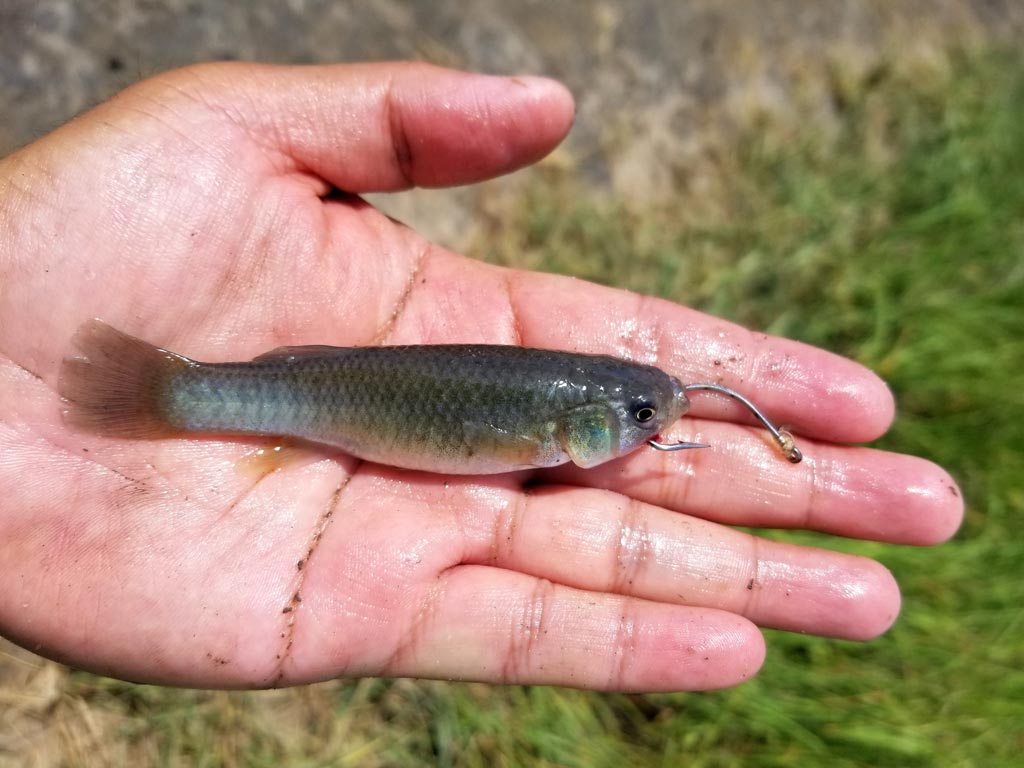
Minnows are nature’s lure for predatory fish, and Trout are no exception. Their erratic, lively swimming motions signal an easy meal, making them especially effective for larger Trout varieties.
The method of hooking a minnow can influence its movements. When hooked through the lips, minnows remain animated for longer. Conversely, when hooked through the back, they adopt the behavior of an injured fish, attracting opportunistic Trout.
Salmon Eggs
Especially during spawning seasons, salmon eggs become prime targets for Trout, specifically Rainbows. These eggs not only resemble native food sources but also release a scent trail in the water.
This aromatic allure, combined with their bright appearance, makes them almost hypnotic to Trout. In waters where Salmon spawn, these eggs are not just recommended – they’re practically essential bait.
Leeches and Hellgrammites
While not the first choice for many anglers, leeches and hellgrammites can be game-changers. These creatures are naturally found in many freshwater habitats and are a meaty treat for Trout.
Their slow, undulating movement in the water can trigger the predatory instincts of Trout, especially in undercurrents where these creatures often reside. Given their size and texture, they often attract larger Trout, making them a worthwhile bait for trophy hunters.
Artificial Lures

- Spinners offer a combination of movement and reflection, mimicking small fish or insects. The rotating blade generates vibrations and visual signals, luring Trout from a distance. Popular brands like Mepps Aglia or Panther Martin Classic Spinner often integrate additional features like feathers for added attraction. Depth and water clarity play a role in spinner choice. For example, in deeper waters, brighter-colored spinners can produce better results.
- Spoons. Designed to resemble injured bait fish, spoons can be invaluable when Trout fishing. Their unique wobble in the water, combined with their reflective surface, indicates vulnerability. Brands like Little Cleo and Kastmaster are revered for their efficacy. The key with spoons is matching the size and color to the prevalent bait fish in the water you’re fishing.
- Soft plastics. This category of fishing lures is expansive and versatile. Their soft bodies give them a natural, lifelike movement in the water, convincing even the weariest of Trout. PowerBait Floating Mice Tails combine elements that Trout love, resembling both a worm and an egg. For added effectiveness, many anglers use fish attractants or scents on their soft plastics, enhancing their allure.
- Jigs are a favorite for their ability to entice Trout at varying depths. The lead head provides weight, allowing the lure to sink, while the feathery or furry tail gives it an enticing movement. Their vertical motion, resembling that of many aquatic creatures, can be irresistible to Trout. While traditional colors like white and yellow remain popular, local variations and preferences should always be taken into account.
Flies
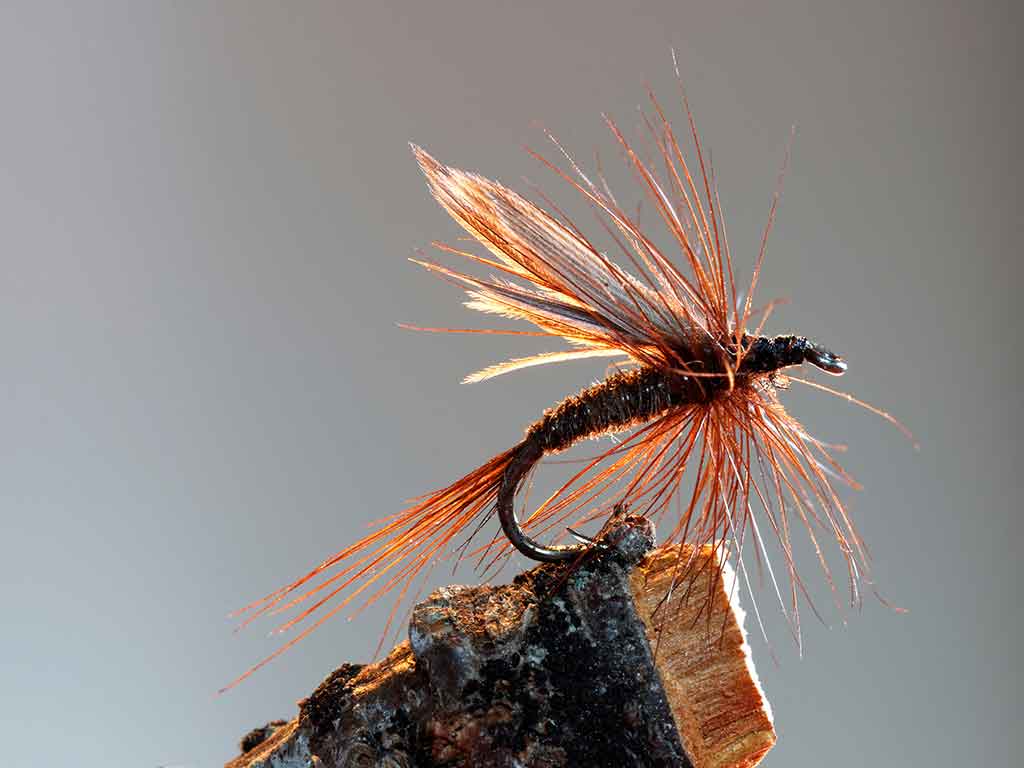
Crafted meticulously to resemble insects at different life stages, flies are an angler’s treasure when fly fishing. Whether replicating nymphs, streamers, or terrestrial insects, flies like the Woolly Bugger or the Royal Coachman have cemented their reputation in the Trout fishing world. The key is to match the hatch – understanding which insects are prevalent and choosing your fly accordingly.
Tips for Using the Right Bait When Trout Fishing
Multi-bait Rigs
Fishing doesn’t always have to be a one-bait affair. Multi-bait rigs allow you to present more than one type of bait simultaneously, significantly improving your odds. For instance, combining an earthworm with a few salmon eggs on a tandem hook setup can prove irresistible to Trout.
The dual scent and visual appeal can often coax reluctant fish to strike, especially in heavily-fished waters where Trout have become wary of single-bait presentations.
Scented Lures
The world of artificial lures has evolved dramatically, with many now coming pre-scented or designed to hold scents for prolonged periods. Lures like Berkley’s PowerBait have gained massive popularity because they combine the visual appeal of a lure with the attraction of natural baits.
If you’re using unscented lures, consider adding fish attractants or even garlic scents. These enhancements can be a game-changer, especially in clear waters where Trout rely more on their sense of smell.
Adjusting with Seasons
Trout behavior changes with the seasons. During the warmer months, they’re more active and often found in cooler, deeper waters. In contrast, the colder months see them venturing into shallower areas. Adjust your bait presentation accordingly.
For instance, in summer, consider using lures that dive deeper, like certain spinners or weighted jigs. In cooler months, floating baits like grasshoppers or surface poppers can be more effective.
Local Knowledge Is King
Before you cast your line, consider talking to local anglers or bait shop owners. Local knowledge can provide invaluable insights into which baits are currently working best. From understanding which artificial lures are in vogue to knowing the most abundant natural bait fish in the waters, these insights can significantly tilt the odds in your favor.
Conservation-Minded Baiting
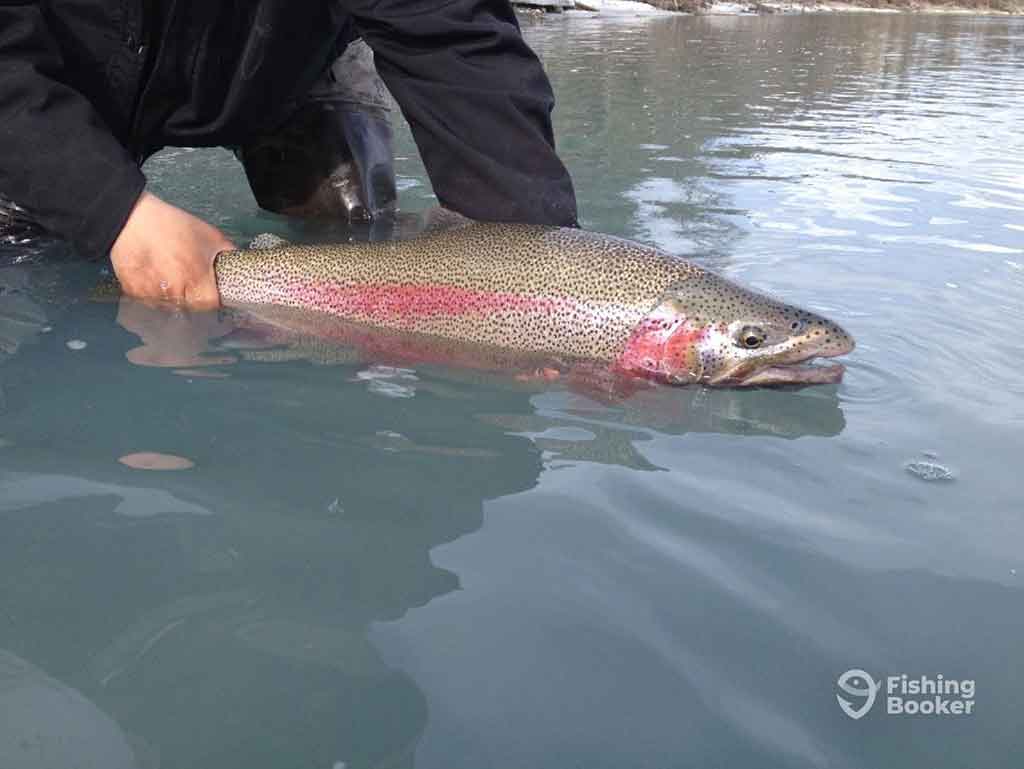
Photo courtesy of Jason’s Guide Service
Catch and release has become increasingly popular among anglers, primarily due to conservation efforts. If you’re practicing this, consider using barbless or circle hooks, making it easier to release the Trout without causing significant harm.
Additionally, if using live bait, ensure that it’s locally sourced to prevent introducing non-native species or diseases into the water.
Presentation Matters
It’s not just what you use – it’s how you use it. Trout can be finicky and a bait presented unnaturally can turn them off. Whether you’re drift fishing with earthworms in a stream or casting lures in a lake, ensure your presentation mimics the natural movements of the local bait. Periodically, check your bait for signs of wear or unnatural behavior, and adjust as necessary.
Trout Fishing Bait: FAQs
While there are baits that are universally appealing to most Trout species, each species has its own preferences based on its diet and habitat. For instance, while earthworms might work well for Rainbow Trout in a particular region, Brook Trout in another area might show a stronger preference for insects. Research the specific Trout species in your fishing area and adjust your bait choices accordingly.
The key is to hook the bait in a way that causes minimal harm, allowing it to move naturally and attractively in the water. For minnows, hooking them through the lips or just behind the dorsal fin can be effective. For worms, thread them onto the hook, ensuring multiple segments are free to wriggle. Always make sure to keep your live bait in aerated containers and out of direct sunlight.
Trout are generally most active during the early mornings and late evenings, especially in warmer months. This is when they come closer to the surface to feed. During these times, using topwater lures or surface-presented live baits can be especially effective. However, the best time can also vary depending on the conditions, so always be observant and adjust your tactics as needed.
If you’re using live bait, it’s crucial to ensure it remains fresh and lively. If your bait fish becomes lethargic or your worm loses its wriggle, it’s time for a change. For artificial lures, while they don’t “expire” like live bait, they can suffer wear and tear, especially after catching fish. Regularly inspect your lures for damages and replace or adjust them as necessary.
Use the Best Trout Baits to Maximize Your Chances
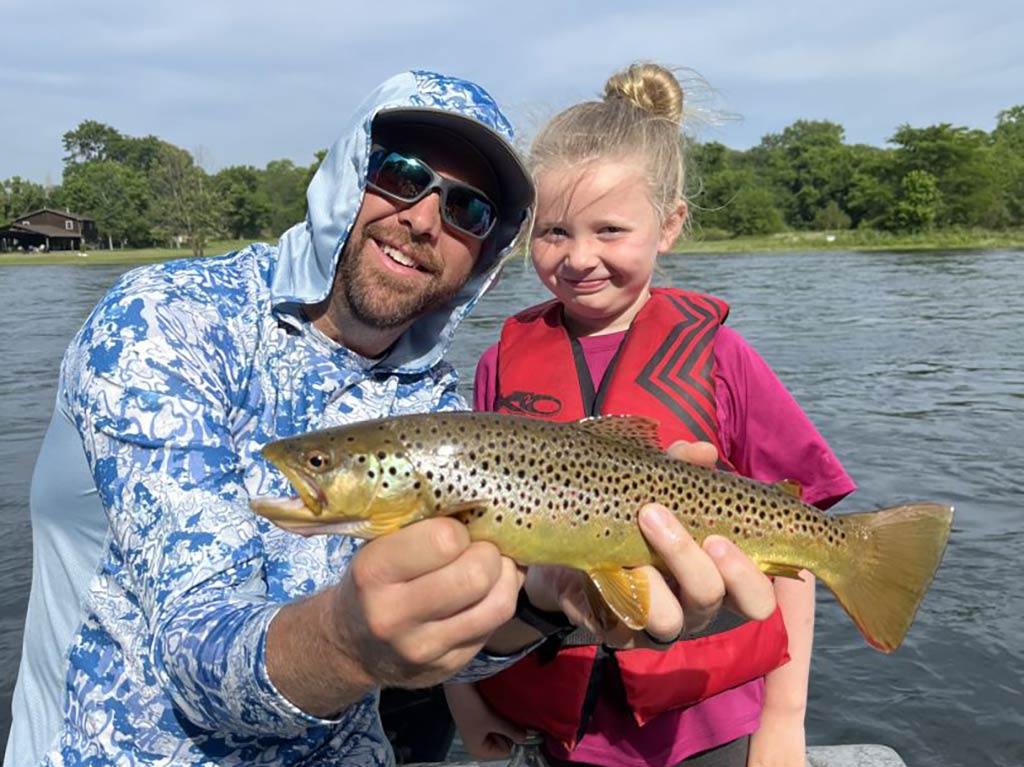
Photo courtesy of Three Rivers Trout Guides
Finding the perfect bait for Trout can be both a science and an art. While there’s no one-size-fits-all answer, understanding the preferences of Trout, coupled with local knowledge and seasonal adjustments, can dramatically increase your success rate.
Whether you’re a seasoned angler or just starting out, always be open to experimenting with different baits and presentations. After all, part of the thrill of fishing is in the challenge and the continual learning it offers. Happy fishing!
What’s your go-to bait for Trout fishing? Do you have a particular lure you always utilize? We’d love to hear from you in the comments below!
The post Best Bait for Trout: An Angler’s Guide appeared first on FishingBooker Blog.
https://fishingbooker.com/blog/best-trout-bait/
 CampingSurvivalistHuntingFishingExploringHikingPrivacy PolicyTerms And Conditions
CampingSurvivalistHuntingFishingExploringHikingPrivacy PolicyTerms And Conditions
